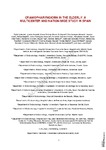Craniopharyngioma in the elderly: a multicenter and nationwide study in Spain

Ver/
Use este enlace para citar
http://hdl.handle.net/2183/29867Coleccións
Metadatos
Mostrar o rexistro completo do ítemTítulo
Craniopharyngioma in the elderly: a multicenter and nationwide study in SpainAutor(es)
Data
2020-10-09Cita bibliográfica
Iglesias P, Nocete I, Moure Rodríguez MD, Venegas-Moreno E, Ares J, Biagetti B, et al. Craniopharyngioma in the elderly: a multicenter and nationwide study in Spain. Neuroendocrinology. 2021;111(10):925-936
Resumo
[Abstract] Background: Craniopharyngioma (CP) is a rare tumor in the elderly whose clinical features and prognosis are not well known in this population. Aim: To evaluate the clinicopathological features and therapeutic outcomes of CP diagnosed in the elderly. Patients and Methods: This was a retrospective, multicenter, national study of CP patients diagnosed over the age of 65 years and surgically treated. Results: From a total of 384 adult CP patients, we selected 53 (13.8%) patients (27 women [50.9%], mean age 72.3 ± 5.1 years [range 65–83 years]) diagnosed after the age of 65 years. The most common clinical symptoms were visual field defects (71.2%) followed by headache (45.3%). The maximum tumor diameter was 2.9 ± 1.1 cm. In most patients, the tumor was suprasellar (96.2%) and mixed (solid-cystic) (58.5%). The surgical approach most commonly used was transcranial surgery (52.8%), and more than half of the patients (54.7%) underwent subtotal resection (STR). Adamantinomatous CP and papillary CP were present in 51 and 45.1%, respectively, with mixed forms in the remaining. Surgery was accompanied by an improvement in visual field defects and in headaches; however, pituitary hormonal hypofunction increased, mainly at the expense of an increase in the prevalence of diabetes insipidus (DI) (from 3.9 to 69.2%). Near-total resection (NTR) was associated with a higher prevalence of DI compared with subtotal resection (87.5 vs. 53.6%, p = 0.008). Patients were followed for 46.7 ± 40.8 months. The mortality rate was 39.6% with a median survival time of 88 (95% CI: 57–118) months. DI at last visit was associated with a lower survival. Conclusion: CP diagnosed in the elderly shows a similar distribution by sex and histologic forms than that diagnosed at younger ages. At presentation, visual field alterations and headaches are the main clinical symptoms which improve substantially with surgery. However, surgery, mainly NTR, is accompanied by worsening of pituitary function, especially DI, which seems to be a predictor of mortality in this population.
Palabras chave
Craniopharyngioma
Pituitary neoplasms
Pituitary neoplasms
Versión do editor
Dereitos
This is the peer-reviewed but unedited manuscript version of the article "Craniopharyngioma in the elderly: a multicenter and nationwide study in Spain". The final, published version is available at Karger web page.
ISSN
0028-3835





